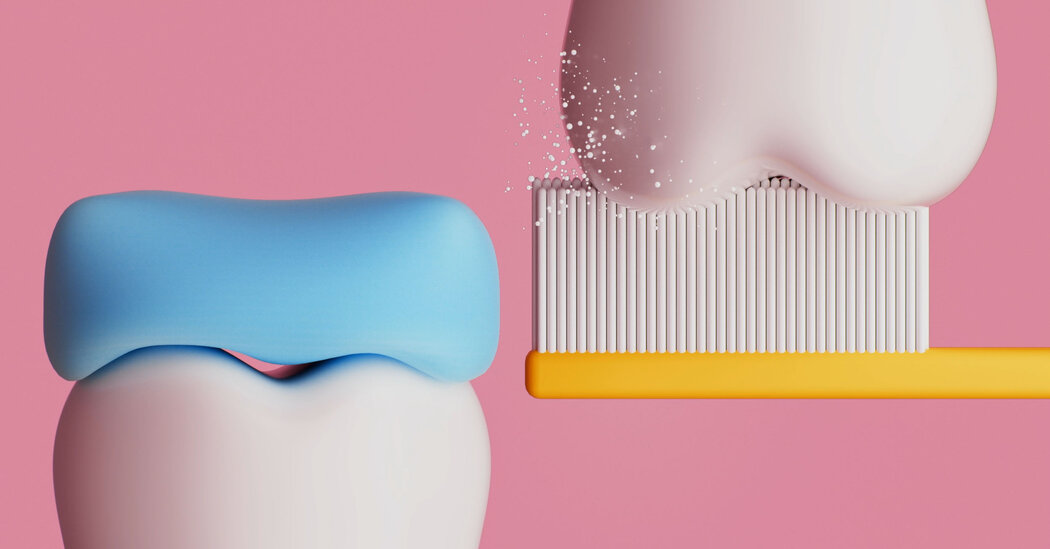Most of us know that the best defense against tooth decay — or damage to the surface, or enamel, of your teeth — is to limit sugary foods and to brush and floss regularly. But once that damage has begun, or even progressed into a cavity, can you reverse it?
Online advertisements for products like cavity-undoing chewing gums and enamel-rebuilding toothpastes and tooth powders suggest that you can.
We asked experts if they work, and if it’s possible to backtrack on tooth decay in the first place.
How does tooth decay happen?
Your mouth is home to both good and bad bacteria, which adhere to your teeth in a sticky layer called plaque.
The bad bacteria love to snack on sugary, starchy foods — like sweetened sodas, gummy candies, pastries and fruit juices — and then turn them into acids that, over time, may pull important minerals from your teeth.
The more these bad bacteria eat, the more acids they produce that dissolve essential minerals like calcium and phosphate, said John Featherstone, a professor emeritus of preventive and restorative dental sciences at the University of California, San Francisco, School of Dentistry.
This dissolution is called demineralization, Dr. Featherstone said, and it can weaken your enamel over months to years until it eventually caves in and forms a cavity.
How quickly this damage, or tooth decay, develops depends mostly on how much of these starchy, sugary foods you consume and how well you clean your teeth, he said.
Can you reverse tooth decay?
Tooth decay is technically reversible, but only if it is caught early, said Dr. Margherita Fontana, a researcher and professor of cariology at the University of Michigan School of Dentistry.
During the earliest stage of tooth decay, when some minerals have been lost just below the tooth’s surface but a cavity has not yet formed, you (or more likely, your dentist) might notice a white — or sometimes brown or black — spot on your tooth, Dr. Fontana said.
At this point, you can reverse tooth decay by adding those important minerals back into your teeth — a process called remineralization, said Dr. Yasmi O. Crystal, an adjunct clinical professor of pediatric dentistry at the N.Y.U. College of Dentistry.
Your saliva, which contains calcium and phosphate, naturally remineralizes your teeth all the time, such as after eating a sugary snack, Dr. Crystal said.
But because most of us eat many foods that bad bacteria like, we can’t depend on saliva alone to prevent or reverse decay, Dr. Featherstone said.
The easiest, cheapest and most effective way to support remineralization is to brush your teeth with toothpaste that contains fluoride, Dr. Crystal said. Fluoride not only reduces the amount of acid that bad bacteria produce, but it also helps saliva to more effectively replenish your teeth with lost minerals by attracting calcium and phosphate to them, Dr. Crystal said.
The fluoride found in most drinking water also bolsters this process, Dr. Fontana said, especially when paired with fluoride toothpaste.
This cavity-fighting duo is enough to reverse early tooth decay in most people, the experts said. But some, like those more prone to decay because they produce less saliva (such as smokers, older adults, postmenopausal women and people taking certain medications), may benefit from more concentrated fluoride products. These include prescription-strength fluoride toothpastes, as well as mouth rinses, varnishes and gels that dentists may apply during a visit or prescribe to use at home.
Chewing sugar-free gum, in addition to your regular oral hygiene routine, may also help reverse early tooth decay, Dr. Featherstone said. Chewing produces saliva that, according to the American Dental Association, contains even more enamel-building minerals than the saliva your mouth makes without stimulation from food.
Gum may also prevent tooth decay by removing food particles from your teeth, Dr. Fontana said.
Once tooth decay has caused a cavity, however, you can’t reverse it and the cavity should be filled, Dr. Crystal said.
But you can stop a cavity from getting worse, said Dr. Domenick T. Zero, a professor at the Indiana University School of Dentistry. Regular dental cleanings and proper oral hygiene — brushing for at least two minutes twice a day and flossing once a day — will keep cavity-causing bacteria out of the hole and prevent it from building up on your teeth, he said.
Do those special products work?
Some limited research has suggested that some ingredients like xylitol and hydroxyapatite in products like remineralizing tooth powders, toothpastes and chewing gums may help reverse tooth decay by adding minerals back to your teeth. However, all of the experts we spoke with said there wasn’t enough evidence to show that they’re more effective at reversing decay than fluoride, or that they work at all.
Among the handful of small clinical trials that have looked into hydroxyapatite toothpastes, for instance, at least two were funded by the product manufacturers. Dr. Fontana also said that these products had been tested mostly on people who are not prone to cavities, so it’s challenging to know how effective they may be for people who actually develop tooth decay.
“No one has shown that any of these products come even close to what fluoride toothpaste does,” she said.
As with many products you see advertised on social media, if they seem too good to be true, they probably are, Dr. Crystal said — “there are no shortcuts.”




